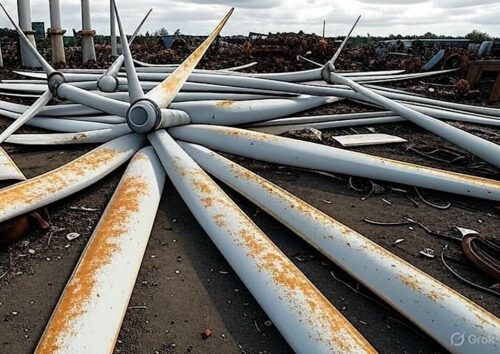While green advocates commonly use the terms renewable, sustainable, and net zero to describe their efforts, the dirty little secret is that much of the waste from solar panels and wind turbines is ending up in landfills. [emphasis, links added]
The current amounts of fiberglass, resins, aluminum and other chemicals — not to mention propeller blades from giant wind turbines — currently pose no threat to local town dumps, but this largely ignored problem will become more of a challenge in the years ahead as the 500 million solar panels and the 73,000 wind turbines now operating in the U.S. are decommissioned and replaced.
Greens insist that reductions in carbon emissions will more than compensate for increased levels of potentially toxic garbage; others fret that renewable energy advocates have not been forthright about their lack of eco-friendly plans and the technology to handle the waste.
“Nobody planned on this, nobody had a plan to get rid of them, nobody planned for closure,” said Dwight Clark, whose company, Solar eWaste Solutions, recycles solar panels. “Nobody thought this through.”
The discussion about what to do with worn-out solar and wind equipment is another topic usually elided in net-zero blueprints, which often focus on the claimed benefits of projects while discounting or ignoring the costs.
As RealClearInvestigations previously reported regarding the lack of plans for acquiring the massive amounts of land for solar and wind farms needed to achieve net zero, the math can get fuzzy, and the numbers cited most frequently are those rosiest for renewables.
“They’ve been either silent, or incoherent — or just hand-wave that we should recycle all this stuff without telling us how,” said Mark Mills, executive director of the National Center for Energy Analytics. In the headlong effort to make solar and wind seem as inexpensive as possible, they have not included fees that address the eventual cost of disposal, which could leave taxpayers holding the bag.
Some renewable supporters acknowledge Mills’ point. The Alliance for Affordable Energy, which supports government-funded research on recycling panels and turbines, said the “circular economy” Mills referred to has yet to materialize.
“With the existing energy infrastructure, a lot of end-of-life questions have never been addressed,” the Alliance’s executive director, Logan Burke, told RCI.
“It may be that those costs have to be embedded in the front end, but somehow we need to make the market circular. How do we find that market at the end of their useful life?”
Just how many panels the U.S. will dispose of or retire each year is also unclear.
No clearing house keeps track of national figures, according to Meng Tao, an energy engineering professor at Arizona State University and a consultant on renewable waste issues.
The estimates can vary widely. Solar panels generally have a life expectancy of 25 years, but factors like damage and system upgrades make the number of panels coming out of circulation each year impossible to ascertain.

In 2021, the National Renewable Energy Laboratory, which did not respond to a request for comment, estimated that between 3,000 and 6,000 panels would be retired annually through 2026.
Critics say even the higher end of those numbers seems suspiciously low given the hundreds of millions of panels now in use and tens of millions yet to come.
The problem will not be confined to the U.S. Several European countries are further down the net-zero road than America, and in March, the European Union estimated it “will cumulatively amass 6-13 and 21-35 million tonnes of [solar] waste by 2040 and 2050, respectively.”
The waste coming from wind turbines will be even greater, the EU said, sounding a hopeful note that recycling renewables will become more prominent.
“Both PV [photovoltaic] and wind power infrastructure waste streams require special handling and recycling methods that are not widespread in Europe today,” the EU wrote.
The U.S. accounts for roughly 10 percent of the waste, according to several experts, and Tao estimated the U.S. would be producing roughly two million metric tons of solar waste a year by 2043, but other studies have a much higher figure.
A 2019 study in renewable energy predicted roughly 10 million metric tons of solar waste between 2030 and 2060.
“Solar waste will grow exponentially in the next 20 years,” Tao said. “Globally, we produced 20-25 million tons of solar panels in 2023. They will come offline in roughly 20 years. That is 20-25 million tons of solar waste a year in 2045.”
The International Renewable Energy Agency puts the potential mountain even higher, pointing to studies that put the 2050 figure at 78 million metric tons.
For now, 90 percent of this detritus goes to landfills. And the panel fields and towering turbines must be dismantled, trucked away, usually by diesel-powered vehicles, and then sent to landfills or ports, where they are shipped to poor, developing countries.
Fossil fuels may foul the air, but renewables may pollute the ground.
Read rest at The Federalist




















Whom ever claimed that Wind & Solar are Environmentally Friendly was knocked on the head by a Coconut way too many Times